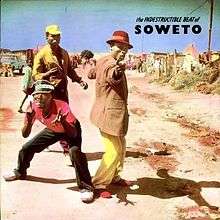The Indestructible Beat of Soweto
| The Indestructible Beat of Soweto | |
|---|---|
 | |
| Compilation album by various artists | |
| Released | 1985 |
| Recorded | 1981–1984 |
| Genre | Mbaqanga, maskanda, mqashiyo, isicathamiya |
| Length | 45:42 |
| Label | Earthworks |
| Producer | various |
The Indestructible Beat of Soweto, later repackaged as The Indestructible Beat of Soweto Volume One, is a compilation album released in 1985 on the Earthworks label, featuring musicians from South Africa, including Ladysmith Black Mambazo and Mahlathini.
Overview
The album was conceived by white South African expatriates Trevor Herman and Jumbo Vanrenen and released in 1985 on the British-based Earthworks label.[1] The following year it was released in the USA by the Shanachie Records label. It features twelve tracks by artists from South Africa. The sleeve notes state that all songs are in the mbaqanga style, a guitar-based style popular at the time in the townships of Johannesburg and Durban, but the tracks actually cover four different styles, mbaqanga, mqashiyo, maskanda, and isicathamiya.[2] The former two are the least traditional-sounding of the styles, while the latter two styles incorporate elements of urban and more rural music. Released prior to the more commercially successful Graceland by Paul Simon, it was one of the first albums of contemporary South African music to be widely available outside the country.[2]
The album has been re-released several times and also spawned a succession of later volumes in the Indestructible Beat series, released by the Earthworks label.[3]
Critical reception
| Professional ratings | |
|---|---|
| Review scores | |
| Source | Rating |
| AllMusic | |
| The Village Voice | A+[5] |
The album was placed in the top 10 in the annual Pazz & Jop poll in the magazine The Village Voice.[6] AllMusic calls it "an essential sampler of modern African styling, a revelation and a joy."[4] Leading critic Robert Christgau gave it an A+ rating,[7] and called it the most important record of the 1980s.[8] It was ranked number 388 in Rolling Stone's 500 Greatest Albums of All Time list.[9]
Track listing
- Awungilobolele [Can You Pay Lobola for Me] - Udokotela Shange Namajaha
- Holotelani [Daughter-In-Law] - Nelcy Sedibe
- Qhude Manikiniki [Fair Fight] - Umahlathini Nabo
- Indoda Yejazi Elimnyama [The Man in the Black Coat] - Amaswazi Emvelo
- Emthonjeni Womculo [The Stream of Music] - Mahlathini Nezintombi Zomgqashiyo and the Makgona Tsohle Band
- Sobabamba [We Will Get Them] - Udokotela Shange Namajaha
- Qhwayilahle [Leave Him Alone] - Moses Mchunu
- Thul'ulalele [Just Stop and Listen] - Amaswazi Emvelo
- Sini Lindile [We Are Waiting for You] - Nganezlyamfisa No Khambalomvaleliso
- Ngicabange Ngaqeda [I Have Made Up My Mind] - Mahlathini Nezintombi Zomgqashiyo and the Makgona Tsohle Band
- Joyce No. 2 - Johnson Mkhalali
- Nansi Imali [Here Is the Money] - Ladysmith Black Mambazo
References
- ↑ Christgau, Robert. "Not Yet Uhuru". The Village Voice. Retrieved 17 October 2009.
- 1 2 Muller, Carol Ann (2008). Focus: Music of South Africa. Routledge. p. 86. ISBN 0-415-96071-1.
- ↑ Eyre, Banning. "Mahlathini and the Mahotella Queens". National Geographic. Retrieved 17 October 2009.
- 1 2 Davis, Hank. "The Indestructible Beat of Soweto, Vol. 1 – Various Artists". AllMusic. Retrieved 17 October 2009.
- ↑ Christgau, Robert (1 April 1986). "Christgau's Consumer Guide". The Village Voice. Retrieved 10 July 2015.
- ↑ Harrington, Richard (4 March 1987). "'Graceland' tops Voice poll - Simon's album wins Jazz and Pop critics' honor". The Washington Post. Retrieved 19 October 2009.
- ↑ "The Indestructible Beat of Soweto (Shanachie, 1986)". Robert Christgau. Retrieved 17 October 2009.
- ↑ Tangari, Joe (4 April 2005). "Africa 100: The Indestructible Beat". Pitchfork Media. Retrieved 17 October 2009.
- ↑ "Various Artists, 'The Indestructible Beat of Soweto'". Rolling Stone.